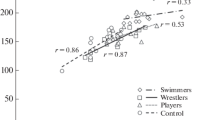Abstract
The aim of the study was to develop some approaches to the substantiation of individual selection criteria for different types of physical training based on the individual chemoreflex responsiveness of the cardiopulmonary system. With this purpose, ventilatory and cardiac responses were studied in groups of young healthy men exposed to increasing inhalation-related hypoxia and hypercapnia. It has been shown that hypoxia induces a predominantly cardiac response, whereas hypercapnia, a predominantly ventilatory response. Based on these predominant chemoreflex responses (of the breathing system to hypercarbia and the cardiac function to hypoxemia), we identified four types of responsiveness in the components of the cardio-pulmonary system: weak for both components (type 1), weak for the cardiac response and strong for breathing (type 2), strong for the cardiac response and weak for breathing (type 3), strong for both components (type 4). The statistical analysis has shown that the types of responsiveness are specific for particular kinds of physical training: type 1, for swimming exercises; types 2 and 3, for skiing races; and type 4, for exercises in boxing, weightlifting, and wrestling. A regression dependence has been found in skiers between an increase in the cardiac responsiveness to hypoxemia and a decrease in the responsiveness of pulmonary ventilation to hypercarbia and a simultaneous increase in oxygen consumption per unit weight. High-class skiers are characterized by a balance between the respiratory and cardiovascular chemoreflex responses. It has been shown that physically untrained subjects are characterized by a pronounced interindividual variability in the cardiopulmonary system’s chemoreflex responses, which can be useful for individualized recommendations in further specialization of sport activities.
Similar content being viewed by others
References
Agadzhanyan, N.A., Gnevushev, V.V., and Katkov, A.Yu., Adaptatsiya k gipoksii i bioekonomika vneshnego dykhaniya (Adaptation to Hypoxia and the Bioeconomics of External Respiration), Moscow: Meditsina, 1987.
Ainslie, P.N. and Duffin, J., Integration of cerebrovascular CO2 reactivity and chemoreflex control of breathing: Mechanisms of regulation, measurement, and interpretation, Am. J. Physiol. Regul. Integr. Comp. Physiol., 2009, vol. 296, p. R1473.
Stewart, J.M., Rivera, E., Clarke, D.A., et al., Ventilatory baroreflex sensitivity in humans is not modulated by chemoreflex activation, Am. J. Physiol. Heart Circ. Physiol., 2011, vol. 300, p. H1492.
Gilmartin, G.S., Lynch, M., Tamisier, R., and Weiss, J.W., Chronic intermittent hypoxia in humans during 28 nights results in blood pressure elevation and increased muscle sympathetic nerve activity, Am. J. Physiol. Heart Circ. Physiol., 2010, vol. 299, p. H925.
Steinback, C.D., Salzer, D., Medeiros, P.J., et al., Hypercapnic vs. hypoxic control of cardiovascular, cardiovagal, and sympathetic function, Am. J. Physiol. Regul. Integr. Comp. Physiol., 2009, vol. 296, p. R402.
Leissner, K.B. and Mahmood, F.U., Physiology and pathophysiology at high altitude: considerations for the anesthesiologist, J. Anesth., 2009, vol. 23, p. 543.
Wilson, M.H., Edsell, M.E., Davagnanam, I., et al., Cerebral artery dilatation maintains cerebral oxygenation at extreme altitude and in acute hypoxia—an ultrasound and MRI study, J. Cereb. Blood Flow Metab., 2011, vol. 31, no. 10, p. 2019.
Shoemaker, J.K., Vovk, A., and Cunningham, D.A., Peripheral chemoreceptor contributions to sympathetic and cardiovascular responses during hypercapnia, Can. J. Physiol. Pharmacol., 2002, vol. 80, p. 1136.
Divert, V.E. and Krivoshchekov, S.G., Cardiorespiratory responses to prolonged normobaric inhalatory hypoxia in healthy men, Fiziol. Chel., 2013, vol. 39, no. 4, p. 407.
Weil, J.V., Byrne-Quinn, V.E., Sodal, I.E., et al., Hypoxic ventilatory response in man, J. Clin. Invest., 1970, vol. 49, p. 1061.
Kolchinskaya, A.Z., Hypoxic hypoxia, hypoxia of effort: Damaging and constructive effects, Hypoxia Med. J., 1993, vol. 1, no. 3, p. 8.
Read, D.J.C., A clinical method for assessing the ventilatory response to carbon dioxide, Austral. Ann. Med., 1967, vol. 16, p. 20.
Wasserman, K., Stringer, W.W., Casaburi, R., et al., Determination of the anaerobic threshold by gas exchange: biochemical considerations, methodology and physiological effects, Z. Kardiol., 1994, vol. 83, Suppl. no. 3, p. 1.
Tamisier, R., Pepin, J.L., Remy, J., et al., 14 nights of intermittent hypoxia elevate daytime blood pressure and sympathetic activity in healthy humans, Eur. Respir. J., 2011, vol. 37, no. 1, p. 119.
Aspenes, S.T. and Karlsen, T., Exercise-training intervention studies in competitive swimming, Sports Med., 2012, vol. 42, no. 6, p. 527.
Platonov, V.N. and Vaitsekhovskii, S.M., Trenirovka plovtsov vysokogo klassa (Training of High-Class Swimmers), Moscow: Fizkul’tura i Sport, 1985.
Phillips, C.L. and O’Driscoll, D.M., Hypertension and obstructive sleepy apnea, Nat. Sci. Sleep, 2013, vol. 5, p. 43.
Skulachev, V.P., Transformatsiya energii v biomembranakh (Energy Transformation in Biomembranes), Moscow: Nauka, 1972.
Khaskin, V.V., Energetika teploobrazovaniya i adaptatsiya k kholodu (The Energetics of Heat Formation and Adaptation to Cold Temperatures), Novosibirsk: Nauka, 1975.
Ivanov, K.P., Osnovy energetiki organizma: teoreticheskie i prakticheskie aspekty. T. 1: Obshchaya energetika, teploobmen i termoregulyatsiya (Basic Principles for the Energetics of the Body: Theoretical and Practical Aspects. Vol. 1: General Energetics, Heat Exchange, and Thermoregulation), Leningrad: Nauka, 1990.
Simpson, A., The effect of Antarctic residence on energy dynamics and aerobic fitness, Int. J. Circumpolar Health, 2010, vol. 69, no. 3, p. 220.
Serebrovskaya, T.V., Sensitivity to hypoxic and hypercapnic stimuli as a reflection of the individual reactivity of the human body, Patol. Fiziol. Eksp. Terap., 1985, no. 5, p. 65.
Kolchinskaya, A.Z., Dykhanie pri gipoksii. Fiziologiya dykhaniya (Respiration in Hypoxia: Physiology of Breathing), St. Petersburg: Nauka, 1994.
Wilmore, J.H., Costill, D. L., Physiology of Sport and Exercise, Champaign: Human Kinetics, 2011, 5th edition.
Mishchenko, V.S., Lysenko, E.N., and Vinogradov, V.E., Reaktivnye svoistva kardiorespiratornoi sistemy kak otrazhenie adaptatsii k napryazhennoi fizicheskoi trenirovke v sporte (Reactive Properties of the Cardiorespiratory System as a Manifestation of Adaptation to Intensive Physical Training in Sports), Kiev: Naukovii Svit, 2007.
Author information
Authors and Affiliations
Corresponding author
Additional information
Original Russian Text © V.E. Divert, S.G. Krivoshchekov, S.N. Vodyanitsky, 2015, published in Fiziologiya Cheloveka, 2015, Vol. 41, No. 2, pp. 64–73.
Rights and permissions
About this article
Cite this article
Divert, V.E., Krivoshchekov, S.G. & Vodyanitsky, S.N. Individual-typological assessment of cardiorespiratory responses to hypoxia and hypercapnia in young healthy men. Hum Physiol 41, 166–174 (2015). https://doi.org/10.1134/S036211971502005X
Received:
Published:
Issue Date:
DOI: https://doi.org/10.1134/S036211971502005X




